A well-organized linen closet brings a surprising amount of calm and efficiency to your daily life. Imagine reaching for fresh towels or sheets without rummaging, finding exactly what you need when you need it. This guide shows you how to transform your linen closet from a chaotic catch-all into a functional, beautiful space, offering practical solutions that fit your real-life schedule and budget. You can achieve lasting order, whether you have a large walk-in closet or a small apartment nook.
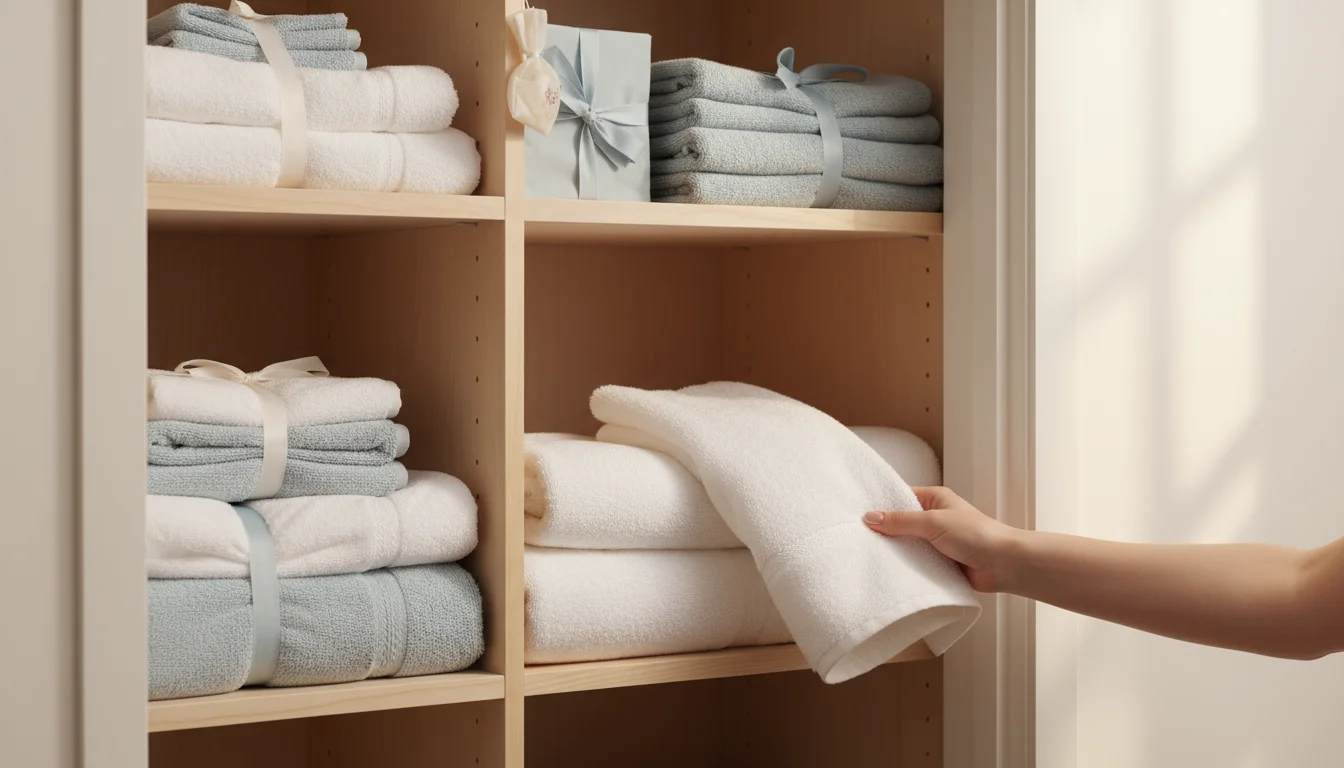
Why Organize Your Linen Closet?
You use your linens constantly, whether you grab a bath towel after a shower or change your bed sheets. A disorganized linen closet wastes your precious time and energy, causing frustration when you cannot find a matching set or a clean washcloth. Beyond saving time, an organized linen closet offers several significant benefits:
- Enhanced Hygiene: Storing items neatly prevents them from accumulating dust, mildew, or odors. Properly folded and stored linens stay fresh longer. Damp towels thrown haphazardly encourage bacterial growth, impacting your family’s health.
- Extended Lifespan of Linens: Crumpled linens sustain more wear and tear. When you store them correctly, you reduce wrinkles and fabric stress, extending the life of your towels, sheets, and blankets. This saves you money over time as you replace items less frequently.
- Maximized Space: You will unlock valuable storage potential in even the smallest closet when you implement effective linen closet organization. Vertical folding and smart container use significantly increase capacity. This often means you do not need to buy more storage furniture, making your home feel more spacious.
- Reduced Stress: Knowing exactly where everything is reduces daily friction. You start your day calmly and complete chores more efficiently. A tidy space contributes to a calmer mind. Studies consistently show a correlation between organized environments and reduced stress levels.
- Clear Inventory: An organized closet allows you to quickly see what you have, helping you avoid unnecessary purchases. You know if you need more guest towels or if your sheet sets are complete, preventing duplicate buying or realizing you lack essentials at the last minute.
Committing to effective linen closet organization is not a luxury, but a practical step towards a more comfortable and functional home.
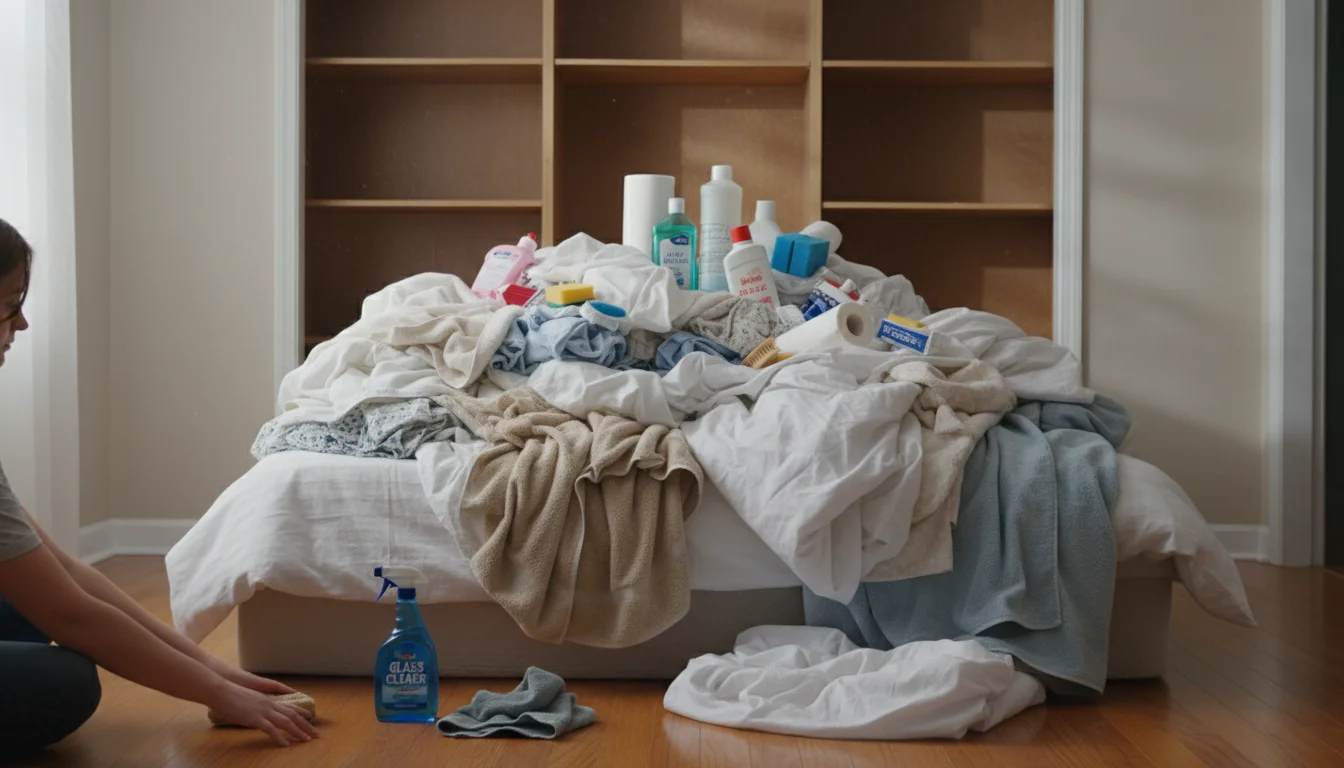
Prepare for Success: Empty, Clean, and Plan
The first step in any organization project involves emptying the space completely. This allows you to assess your current situation and start with a clean slate. Do not skip this crucial stage, as it provides the foundation for your new system.
Here is your action plan:
- Empty Everything Out: Remove every single item from your linen closet. This includes towels, sheets, blankets, pillowcases, cleaning supplies, toiletries, first-aid kits, or anything else that has found its way in. Place items on a bed, floor, or table, ensuring you have enough space to sort through them.
- Clean the Closet Thoroughly: Once empty, clean the interior of your closet. Wipe down shelves, dust corners, and vacuum the floor. If you notice any stubborn marks or residue, use an all-purpose cleaner. Pay attention to any lingering odors and consider placing a baking soda box or an odor absorber inside to neutralize them. A clean space ensures your newly organized linens remain fresh. For advice on cleaning and disinfecting, refer to resources like the CDC’s cleaning guidelines.
- Assess the Space: Look at your closet’s structure. Do you have adjustable shelves? Are there any hidden corners or wasted vertical space? Note the dimensions of your shelves and the overall height and width of the closet. This assessment informs your storage choices later. Consider if tension rods could add extra hanging space or if stackable bins would maximize vertical room.
- Gather Your Supplies: Before you start putting things back, collect any tools or containers you might need. This prevents interruptions once you begin the organizing process. Suggested supplies include:
- Trash bags (for discards)
- Donation bags (for items in good condition)
- Cleaning supplies (rags, spray cleaner)
- Measuring tape
- Labels and a marker
- Any new baskets, bins, or shelf dividers you plan to use
Having everything at hand makes the process smoother and more efficient.
This preparation stage sets you up for successful linen closet organization. Do not underestimate its power to clarify your goals and streamline the subsequent steps.
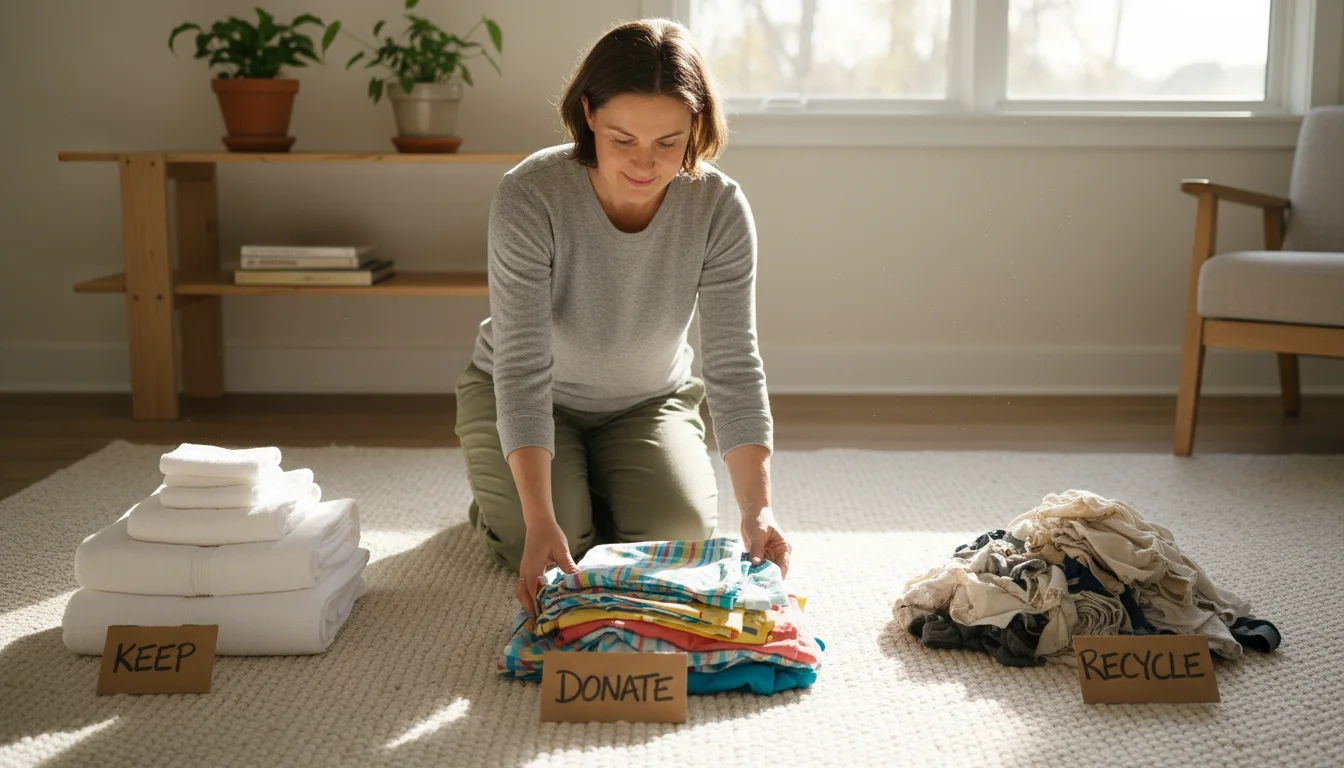
Declutter Ruthlessly: The Key to Lasting Order
Decluttering forms the most critical step in achieving effective linen closet organization. You cannot organize clutter, you only move it around. This stage requires honesty about what you truly need and use. Tackle this segment with a clear mind and a practical perspective.
Divide your items into three categories: Keep, Donate/Repurpose, and Discard.

1. The “Keep” Pile: What Deserves a Place in Your Closet
Apply these criteria to each item:
- Good Condition: Keep only items free from tears, stains, holes, or excessive wear. Even small imperfections can make a towel or sheet feel less luxurious and functional.
- Regularly Used: Do you actually use this item? Consider your family size and how often you do laundry. Most households need 2-3 sets of sheets per bed and 2-3 sets of towels per person. Excess simply occupies valuable space. For `towel storage`, ensure you have enough for regular use, plus a few for guests.
- Matching Sets: For `sheet organization`, keep complete sets. If a pillowcase is missing or a flat sheet is orphaned, consider letting it go unless it serves a specific purpose (e.g., a spare pillowcase for decorative pillows).
- Proper Fit: Ensure your sheets fit your mattresses correctly. Old sheets that no longer fit well cause discomfort and look messy.
Be honest about seasonal items. If you use a heavy comforter only three months a year, designate a specific, space-saving storage solution for it outside the main closet.
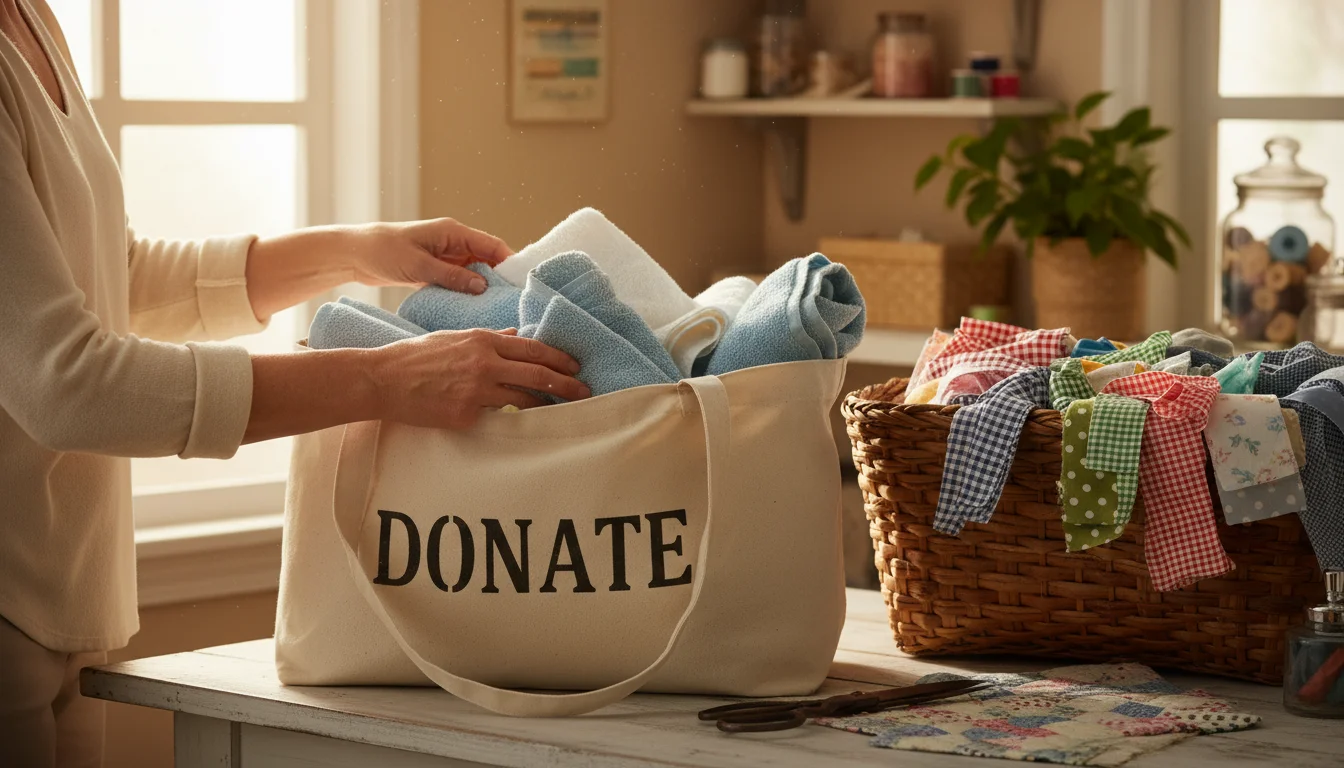
2. The “Donate/Repurpose” Pile: Giving Items a Second Life
Many items you no longer need can still benefit others:
- Donate: Linens in good, clean condition but no longer needed by you are excellent for donation. Local homeless shelters, animal shelters, thrift stores, or community centers often welcome clean sheets, towels, and blankets. Always check with the organization first regarding their specific needs and donation guidelines.
- Repurpose: Even stained or torn towels and sheets have value. Cut them into rags for cleaning, use them as drop cloths for painting, or save them for pet messes. Old pillowcases make great storage bags for shoes or craft supplies. Old towels become car wash rags. This creative approach prevents waste and provides practical utility.

3. The “Discard” Pile: When It’s Time to Let Go
Some items are simply beyond use:
- Severely Damaged: Items that are extensively torn, frayed, or heavily stained should go directly into the trash. They no longer serve their original purpose and cannot be repurposed effectively.
- Mold or Mildew: Linens with persistent mold or mildew odors, or visible growth, are a health hazard and belong in the trash. No amount of washing will truly salvage them.
The goal here is to reduce your inventory to only what you love, use, and truly need. This streamlined collection makes subsequent `linen closet organization` steps significantly easier and more sustainable.
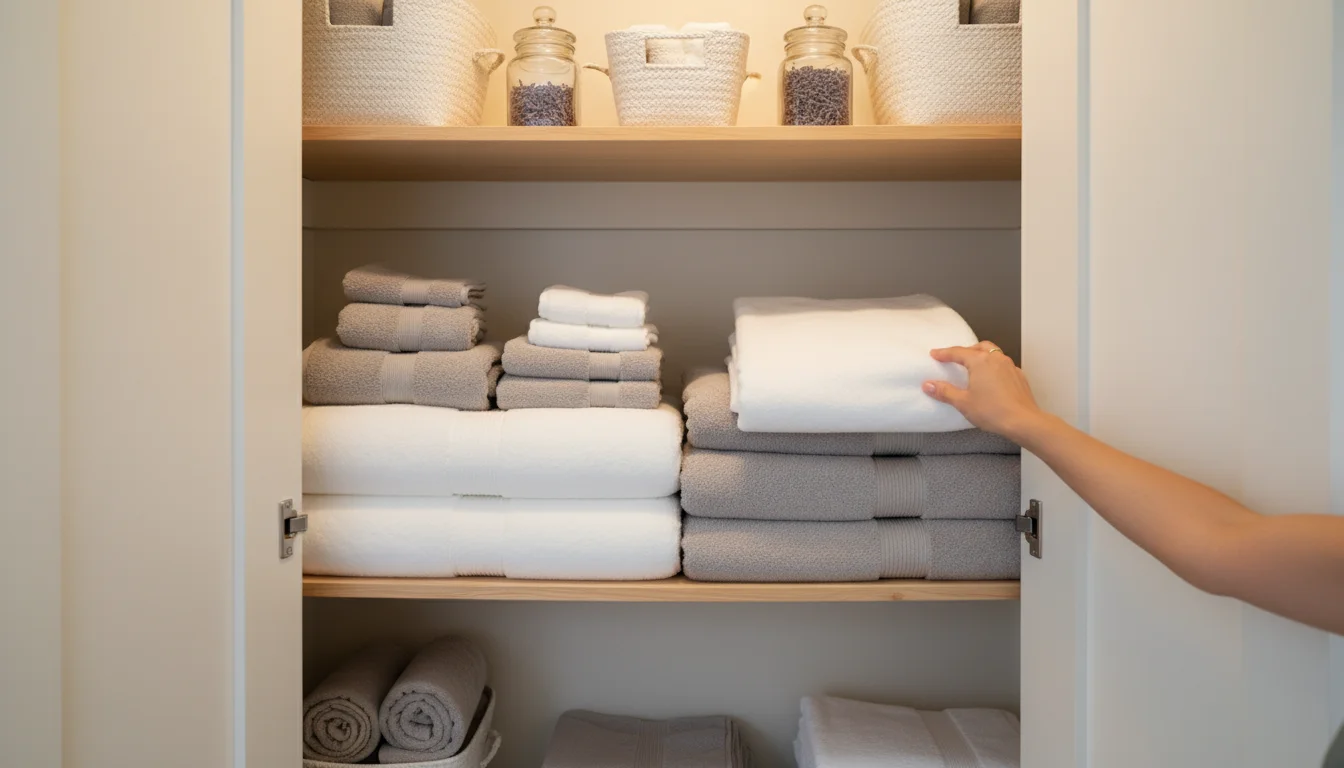
Create Zones for Ultimate Functionality
Zoning means designating specific areas for specific types of items. This principle forms the backbone of effective linen closet organization, ensuring every item has a “home.” When you establish clear zones, you reduce clutter, save time, and maintain order effortlessly. Think of your closet as prime real estate, where you assign sections based on frequency of use and item type.
Here are common zones to consider for your linen closet:
- Everyday Bath Linens (Eye Level): Place your most frequently used towels, hand towels, and washcloths on shelves at eye level or easily accessible heights. This zone should be within easy reach for daily use. Proper `towel storage` here means neatly folded items that you can grab without disturbing other stacks.
- Bed Linens (Middle Shelves): Store your primary sheet sets for each bedroom here. Group sheet sets together, perhaps inside one of their pillowcases, to keep them tidy. This makes changing beds a swift task. Dedicate a shelf or section for each bedroom’s linens, enhancing your `sheet organization`.
- Guest Linens (Less Accessible, Clearly Labeled): If you host guests occasionally, dedicate a separate, perhaps higher or lower, shelf for guest towels and sheets. Label this section clearly to avoid mixing them with your everyday items. You can store these items in a breathable storage bag or a dedicated bin to keep them fresh until needed.
- Seasonal Items (Top Shelves or Deep Storage): Bulky items like heavy winter blankets, extra duvets, or seasonal throws belong on the top shelves, as you access them less frequently. Consider using vacuum-seal bags to compress these items, saving significant space and protecting them from dust and allergens.
- Overflow or Backup (Bottom Shelves): If you have an abundance of certain items, such as extra toilet paper rolls, large bottles of cleaning solutions, or additional toiletries, the bottom shelves are ideal. These areas can handle heavier loads and are less visible, maintaining a tidy appearance in your main display areas.
- First Aid/Toiletries (Small Bins or Drawers): Small items like medicines, bandages, or personal care products benefit from being contained in small, labeled bins or drawers. This prevents them from scattering and keeps them organized within a larger zone. If your linen closet is deep, a drawer organizer or a narrow shelf can be incredibly useful.
When you define these zones, you simplify your `linen closet organization`. Each item gains a purpose-driven location, making it intuitive to put things away and find them quickly. This system reduces decision fatigue and maintains order over the long term.
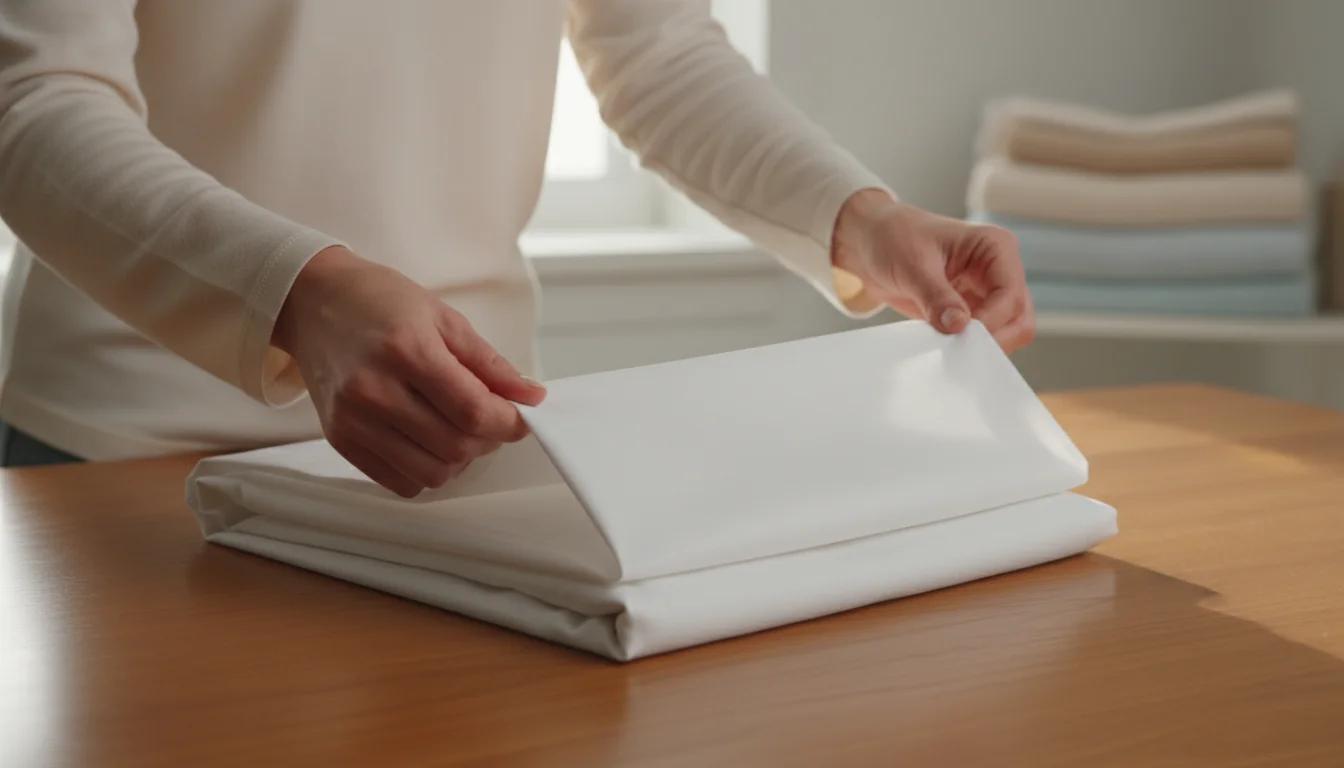
Master Folding Techniques for Neat Towel and Sheet Organization
The way you fold your linens profoundly impacts your `linen closet organization`. Neat, uniform folds save space, prevent wrinkles, and make your closet look tidy and inviting. Say goodbye to haphazard piles and embrace these space-saving techniques.
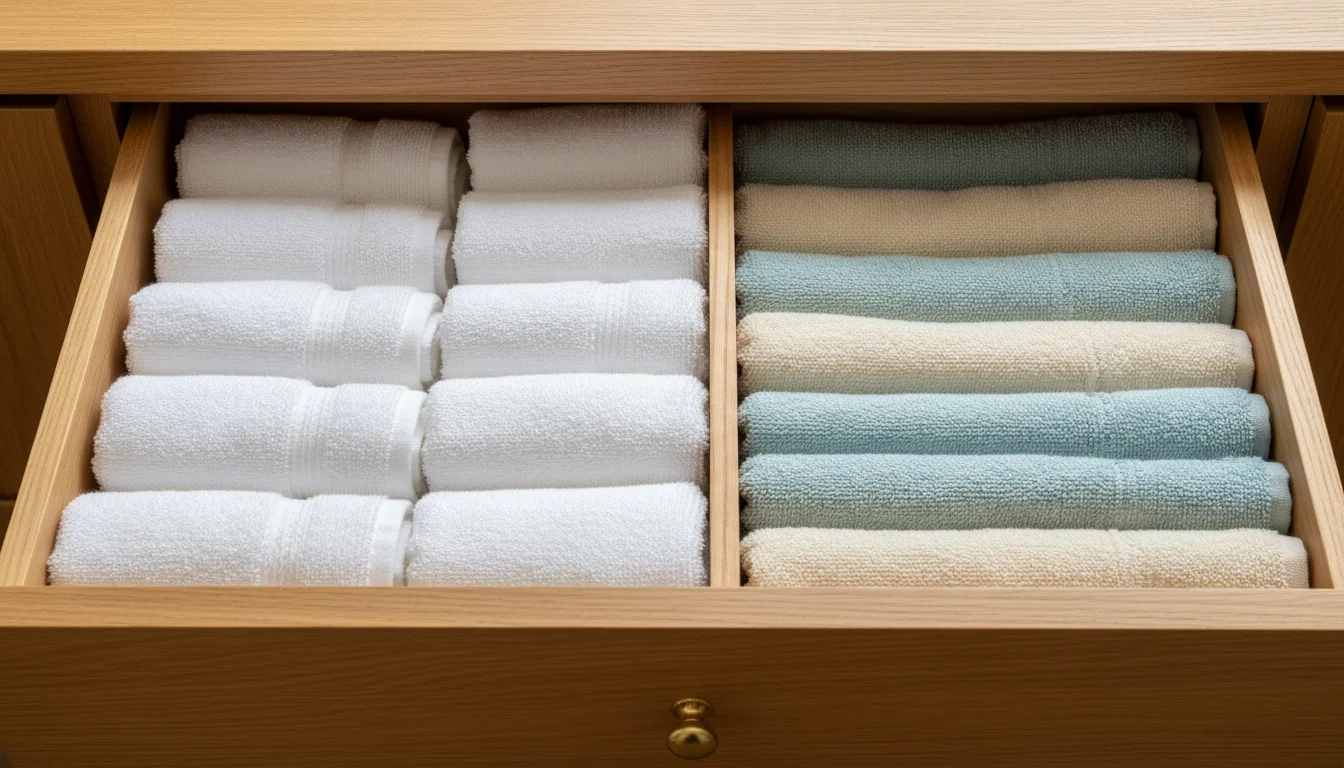
Efficient Towel Storage: The Art of the Perfect Fold
For `towel storage`, you have a few excellent options, depending on your closet’s depth and your preference:
- The Standard Square/Rectangle Fold:
- Lay the towel flat.
- Fold it in half lengthwise.
- Fold it in half lengthwise again.
- Fold it into thirds or fourths across the width, creating a neat, rectangular block.
- Stack these vertically or horizontally, depending on your shelf depth. This method works well for standard stacking.
- The KonMari Vertical Fold (Space Saver):
- Lay the towel flat.
- Fold one long edge towards the center, then the other long edge towards the center, meeting or slightly overlapping. This creates a long, narrow strip.
- Fold this strip in half.
- Fold it into thirds or fourths again until it stands upright on its own.
- Store towels vertically, side-by-side, in baskets or directly on shelves. This allows you to see all towels at a glance and pull one out without collapsing the stack. This method is incredibly efficient for narrow or deep shelves.
- Rolling Towels (Spa Aesthetic):
- Lay the towel flat.
- Fold it in half lengthwise.
- Starting from one end, tightly roll the towel into a cylinder.
- Arrange rolls in baskets or on shelves. This method maximizes visual appeal but might use slightly more space than vertical folding. It is excellent for hand towels or guest towels.
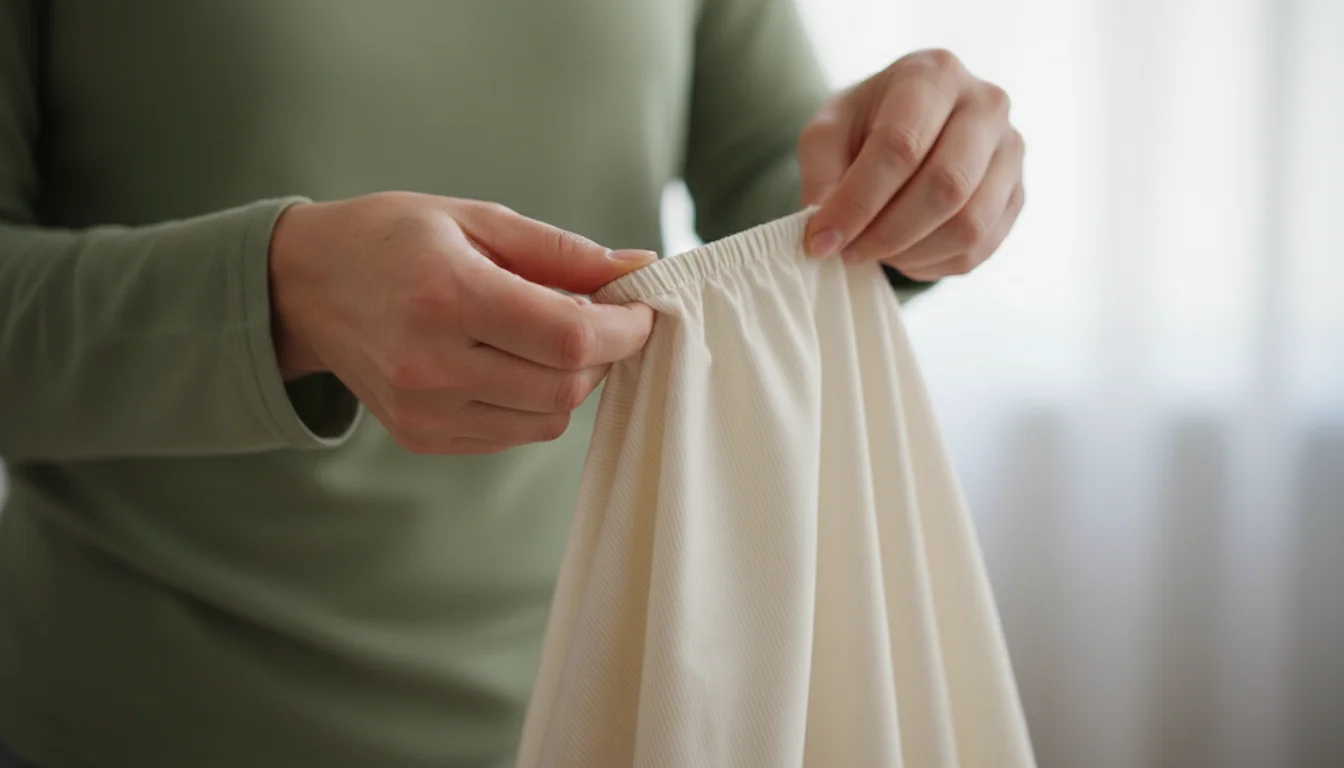
Streamlined Sheet Organization: Taming the Fitted Sheet
Fitted sheets often present the biggest challenge in `sheet organization`. Master this fold, and the rest becomes simple.
Folding a Fitted Sheet:
- Turn the fitted sheet inside out. Place your hands into the two top corners.
- Bring your right hand to your left, folding the right corner over the left. The elastic edge of the right corner should neatly tuck into the elastic edge of the left corner.
- Now, you have two fitted corners over two fitted corners. Bring the bottom left corner up to meet the now-combined top left corner, folding the elastic edge over.
- Repeat with the last corner. You should now have a neatly folded, long rectangle with all the elastic edges tucked inside.
- Lay the sheet flat on a surface, elastic edges down.
- Fold the sheet into a rectangle, similar to a flat sheet or towel. First fold one long side in, then the other.
- Fold into thirds or fourths to create a compact, flat rectangle.
Organizing Sheet Sets:
Once folded, keep your sheet sets together. The most popular method involves storing the entire folded set (fitted sheet, flat sheet, and pillowcases) inside one of the matching pillowcases. This keeps everything together, prevents misplacing items, and makes grabbing a complete set incredibly easy.
By implementing these folding techniques, you create visually appealing stacks and maximize every inch of your linen closet. This precision is a cornerstone of effective `linen closet organization`.
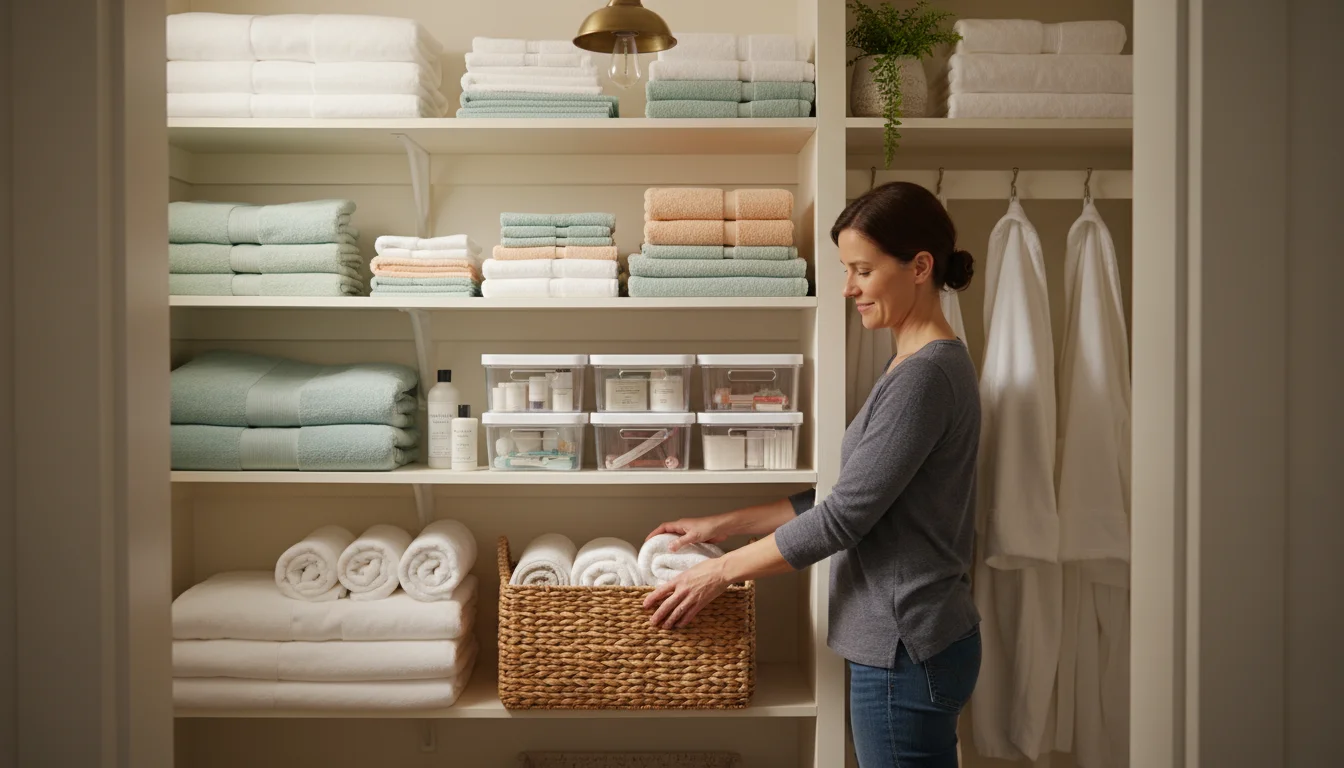
Smart Storage Solutions for Every Space and Budget
Effective `linen closet organization` involves more than just folding. The right storage solutions help maintain order, protect your linens, and utilize your space efficiently. You can achieve a highly functional and beautiful closet regardless of your budget, mixing and matching solutions to suit your needs.
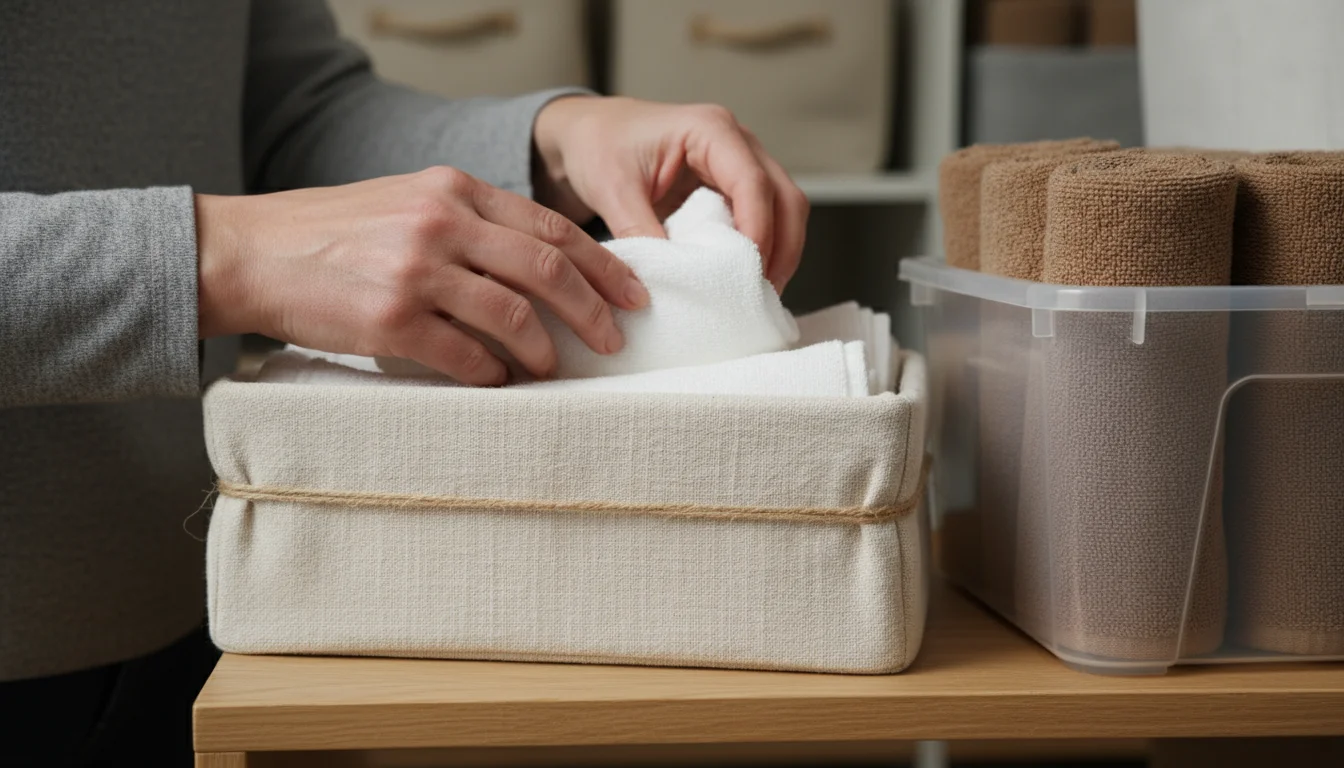
DIY and Budget-Friendly Solutions:
- Shoe Boxes or Cardboard Boxes: Repurpose clean, sturdy shoe boxes or other cardboard boxes. Cover them with decorative paper or fabric for a more aesthetically pleasing look. These are excellent for containing smaller items like washcloths, toiletries, or first-aid supplies. They are free or very low cost and provide immediate compartmentalization.
- Dollar Store Baskets/Bins: Look for plastic or wire baskets at dollar stores or discount retailers. These are perfect for grouping similar items, like all hand towels or all washcloths, preventing them from toppling. Clear bins are particularly useful because you can see the contents without pulling them out.
- Tension Rods: Install tension rods to create extra hanging space for table linens, bath mats, or even to separate stacks of items on a shelf. A tension rod can also hold spray bottles of cleaning supplies, freeing up shelf space.
- Magazine Files: Upright magazine files work wonderfully for storing folded sheets or smaller blankets vertically, similar to how you would store them using the KonMari method. This keeps them tidy and accessible.
- Old Drawers/Baskets: If you have old drawers from a disassembled piece of furniture or charming vintage baskets, repurpose them. They add character while providing practical storage.
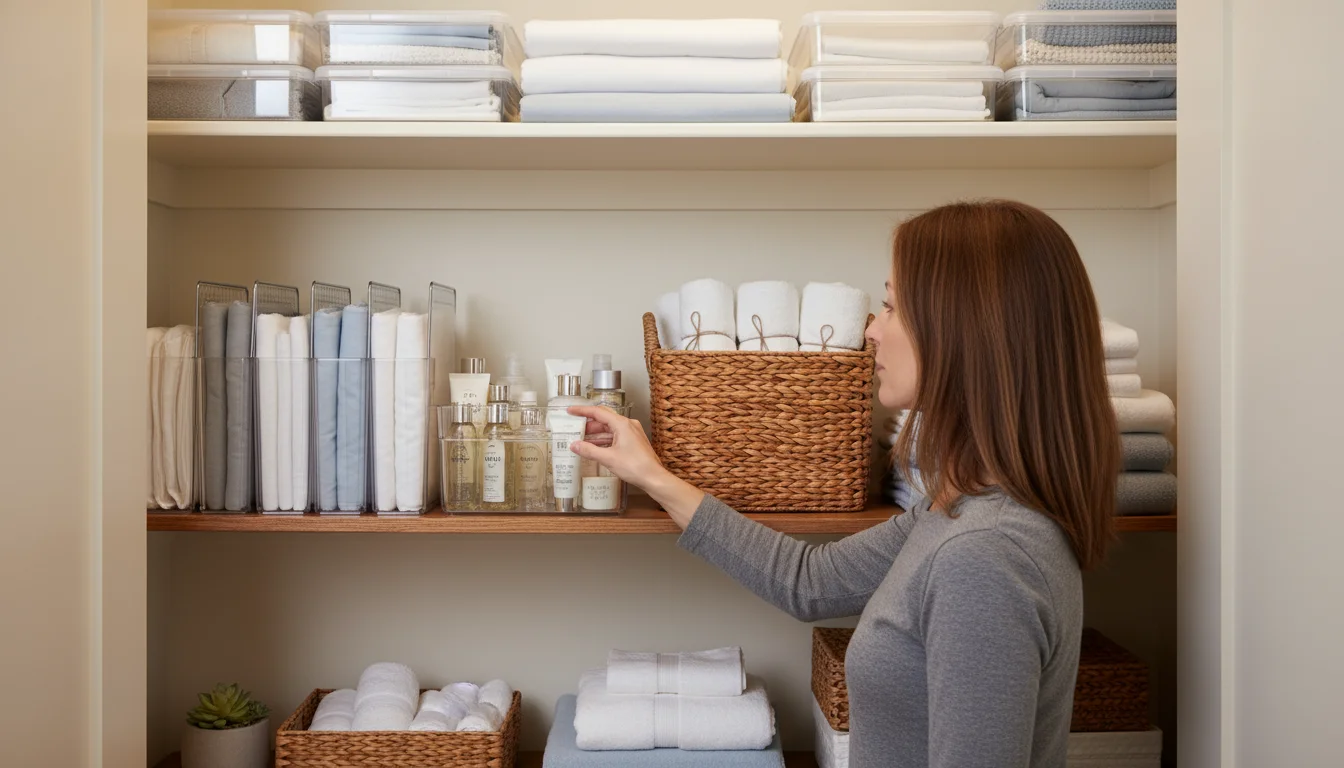
Mid-Range and Investment Pieces:
- Woven Baskets: Rattan, wicker, or fabric baskets add warmth and texture to your closet. They are excellent for containing bulkier items like blankets, throws, or guest towels. Choose baskets with handles for easy retrieval.
- Clear Acrylic Bins: These provide a sleek, modern look and allow you to see contents at a glance. They are durable and easy to clean, ideal for toiletries, cleaning supplies, or smaller folded linens.
- Shelf Dividers: Metal or plastic shelf dividers slide onto shelves and create instant compartments, preventing stacks of towels or sheets from falling over. This is particularly useful for wide shelves where items tend to lean.
- Stackable Storage Bins: Clear, stackable bins with lids protect items from dust and allow you to build vertical storage. Use these for seasonal items or less frequently used linens.
- Drawer Organizers: If your linen closet includes drawers, use acrylic or bamboo drawer organizers to keep small items like toothbrushes, soaps, or first-aid essentials neatly segmented.
- Over-the-Door Organizers: A multi-pocket over-the-door organizer is a game-changer for small closets or renters. Use it for small toiletries, cleaning supplies, extra paper towels, or even rolled-up hand towels.
- Vacuum Storage Bags: For bulky items like duvets, comforters, or seasonal blankets, vacuum storage bags compress items by up to 80%, saving immense space. These are an excellent investment for maximizing storage in tight spaces, but ensure linens are completely dry before sealing to prevent mildew.
When selecting solutions for `linen closet organization`, consider the look you want, the items you store, and your budget. Remember to measure your shelves and items before purchasing anything to ensure a perfect fit. Sites like IKEA Home Organization and The Container Store — Organization Tips offer a wide range of products for inspiration.
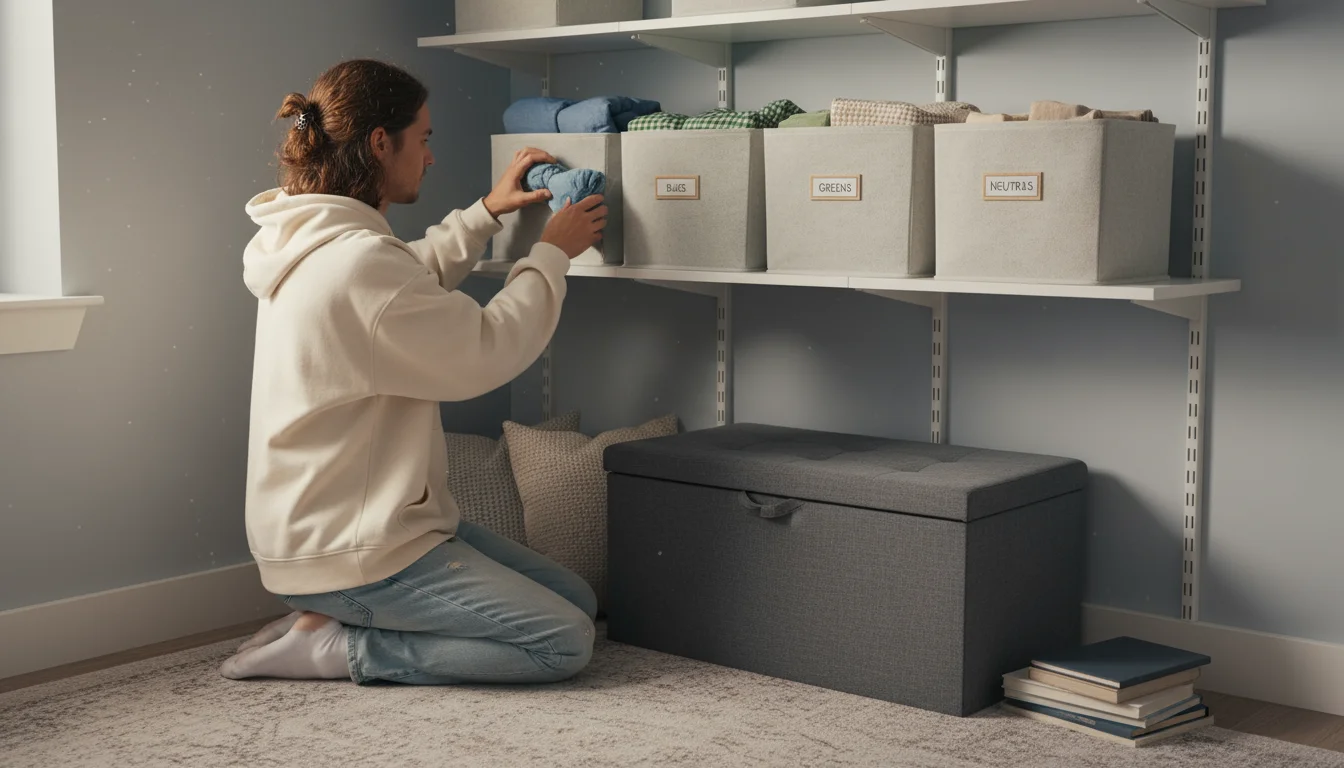
Optimizing Small Spaces and Non-Traditional Linen Storage
Not everyone has a dedicated, spacious linen closet. Many apartment dwellers, renters, or homeowners with older homes face the challenge of minimal storage. Do not despair. You can achieve excellent `linen closet organization` even in compact or unconventional spaces. The key involves creative thinking, maximizing vertical space, and utilizing underutilized areas.
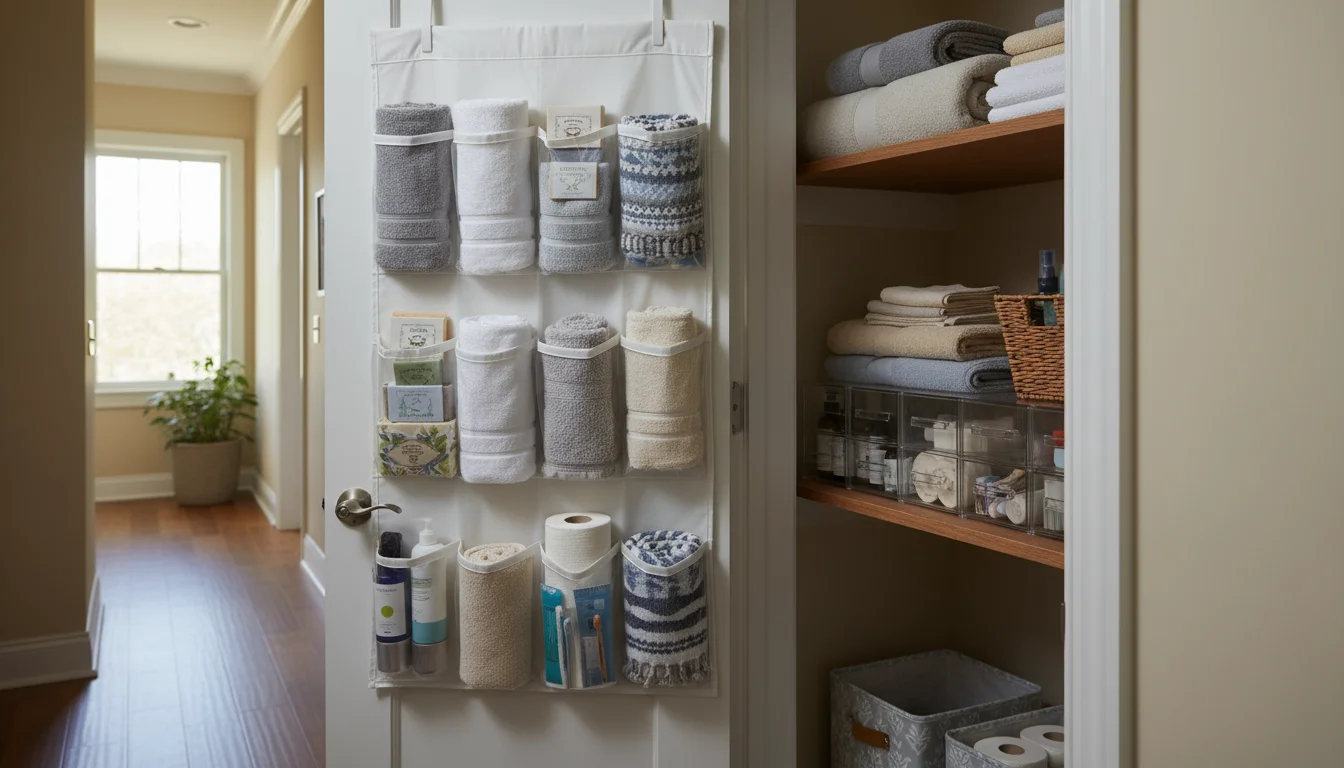
Strategies for Small Linen Closets:
- Embrace Vertical Space: When horizontal space is limited, go vertical. Use multi-tier shelves, stackable bins, or shelf risers to create more levels within your existing shelves. This is crucial for maximizing `towel storage` and `sheet organization`.
- Door Storage: An over-the-door organizer with clear pockets or shelves is an indispensable tool. Use it for smaller items like toiletries, cleaning supplies, rolled-up hand towels, or even thin guest blankets. This utilizes space that often goes overlooked.
- Slim Bins and Baskets: Opt for narrow bins and baskets that fit snugly on shelves. Measure carefully to ensure you use every inch of depth and width without creating dead space.
- Fold Smartly: As discussed, the KonMari vertical fold for towels and the contained sheet set method are non-negotiable for small spaces. They create uniform, compact bundles that maximize shelf capacity.
- Declutter Relentlessly: For a small closet, strict decluttering is paramount. You simply do not have room for items you do not regularly use or that are past their prime. Every item must earn its place.
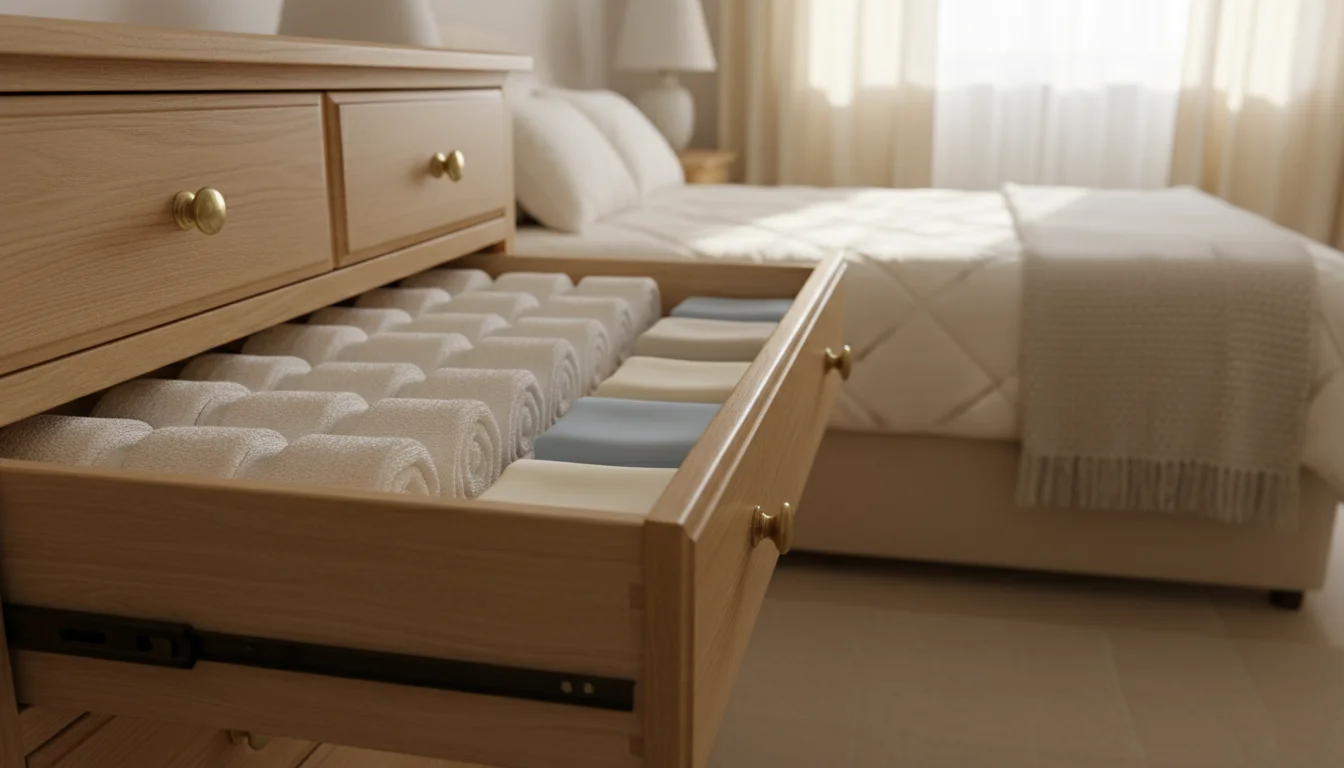
Non-Traditional Linen Storage Solutions:
When a dedicated linen closet is not an option, think outside the box. Your linens can find comfortable and functional homes elsewhere:
- Under-Bed Storage: Utilize under-bed space with rolling storage bins or vacuum-sealed bags. This is perfect for seasonal blankets, extra pillows, or backup sheet sets. Ensure containers are breathable or linens are thoroughly dry before storing long-term.
- Dresser Drawers: Assign a drawer in a bedroom dresser or a hallway console table specifically for linens. Roll towels or vertically fold sheets to fit neatly. This keeps items close to where they are used.
- Storage Ottomans or Benches: Furniture with built-in storage offers a stylish and practical solution. Use them in living rooms for throws, or at the foot of a bed for extra blankets and pillows.
- Wardrobe or Armoire: If you have an extra wardrobe or armoire, dedicate a shelf or two to linens. Add small bins or shelf dividers to keep items distinct from clothing.
- Wall-Mounted Shelves: In a bathroom or laundry area, install simple wall-mounted shelves. Store neatly folded, aesthetically pleasing towels or stack small baskets with toiletries. This turns practical storage into a design feature.
- Rolling Carts: A slim, multi-tiered rolling cart can tuck into a narrow space in a bathroom, laundry room, or even a hallway. Use it to store folded towels, cleaning supplies, or bath essentials. The mobility is a bonus for flexible storage.
Remember that the goal of `linen closet organization` extends beyond a single closet. It encompasses creating efficient and accessible storage for all your linens, wherever that may be in your home. Be creative, measure your spaces, and implement solutions that genuinely work for your unique living situation. For more creative small-space solutions, explore resources like Apartment Therapy.
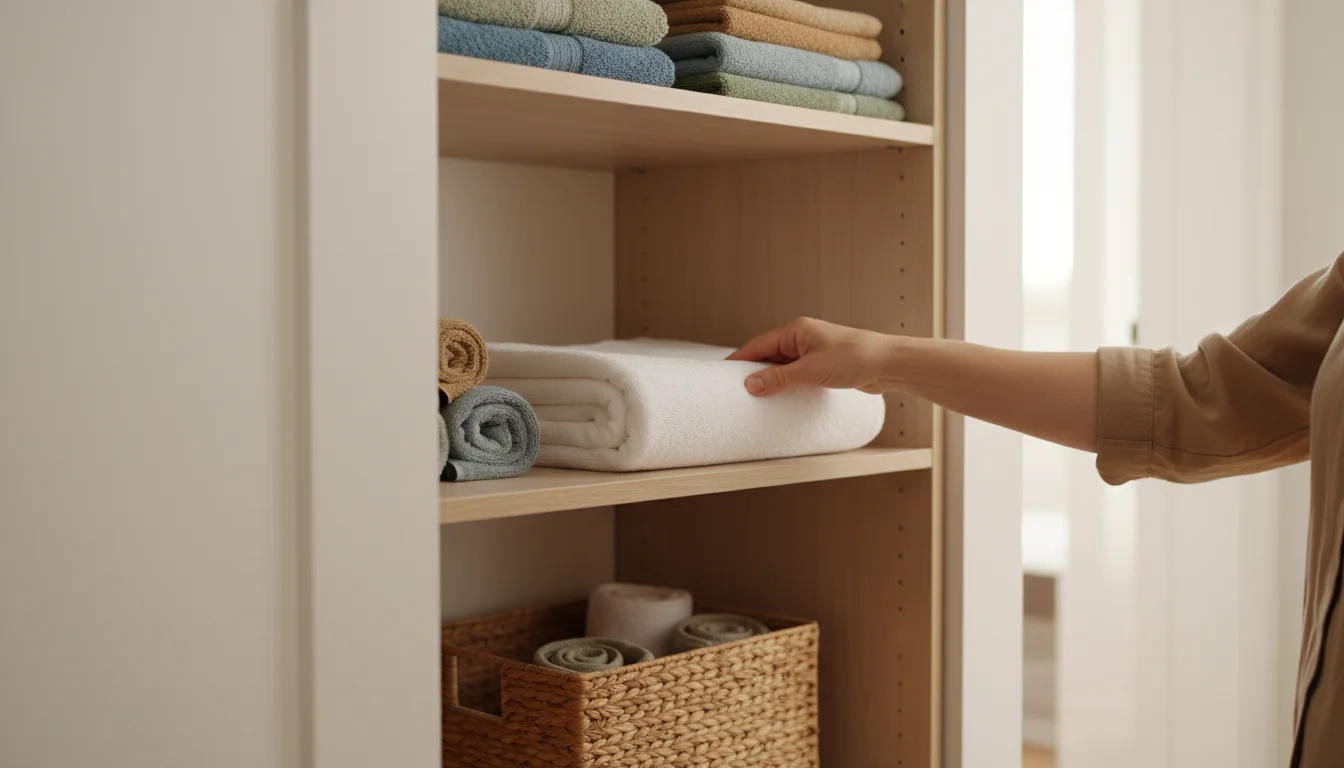
Maintaining Your Organized Linen Closet for Long-Term Peace
Organizing your linen closet is a fantastic achievement, but maintaining that order ensures its long-term benefits. A well-designed system should be easy to uphold, preventing the slow creep of clutter. Consistency and a few simple habits make all the difference, keeping your `linen closet organization` pristine without constant overhauls.
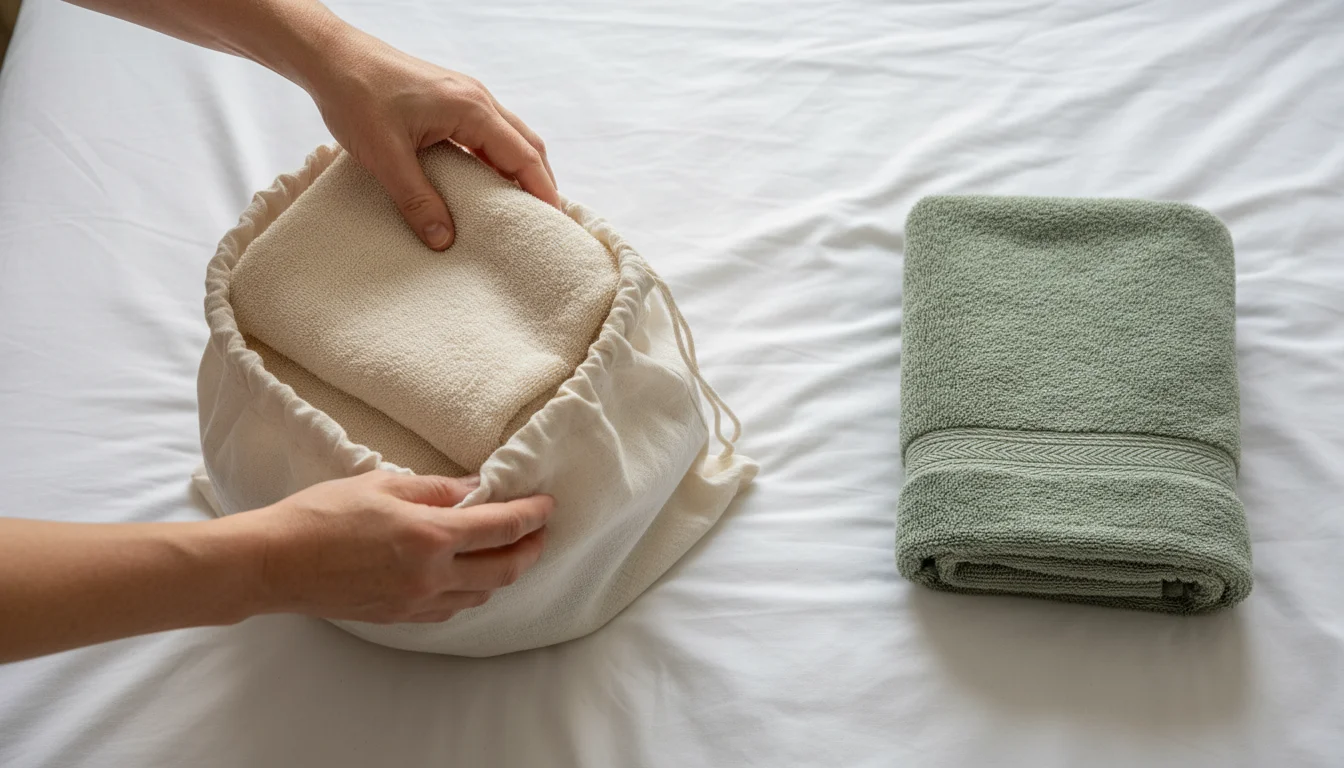
Establish Smart Habits:
- The “One In, One Out” Rule: When you purchase a new towel or sheet set, commit to donating or discarding an old one. This prevents your inventory from growing unmanageably and helps you maintain the ideal quantity you established during your decluttering phase. This rule is particularly effective for `towel storage` and `sheet organization`.
- Immediate Folding and Storage: As soon as you finish laundry, fold items neatly and return them to their designated zones. Avoid creating “laundry mountains” that can quickly unravel your system. Integrating folding into your laundry routine saves time in the long run.
- Regular Rotation: Rotate your linens to ensure even wear and tear. Place freshly laundered items at the bottom of stacks or behind existing items. This prevents the same few towels or sheets from being used repeatedly, extending the life of your entire collection.
- Airing Out Your Closet: Periodically leave your linen closet door ajar for a few hours. This allows air to circulate, preventing stale odors and helping to maintain freshness, especially in humid environments. You can also place a sachet of dried lavender or cedar blocks for a pleasant scent and natural pest deterrent.
- Quick “Tune-Ups”: Dedicate five minutes once a week or every two weeks to a quick straighten-up. Refold any items that have shifted, wipe down a dusty shelf, or adjust baskets. These small, consistent efforts prevent minor disarray from becoming a major reorganization project.
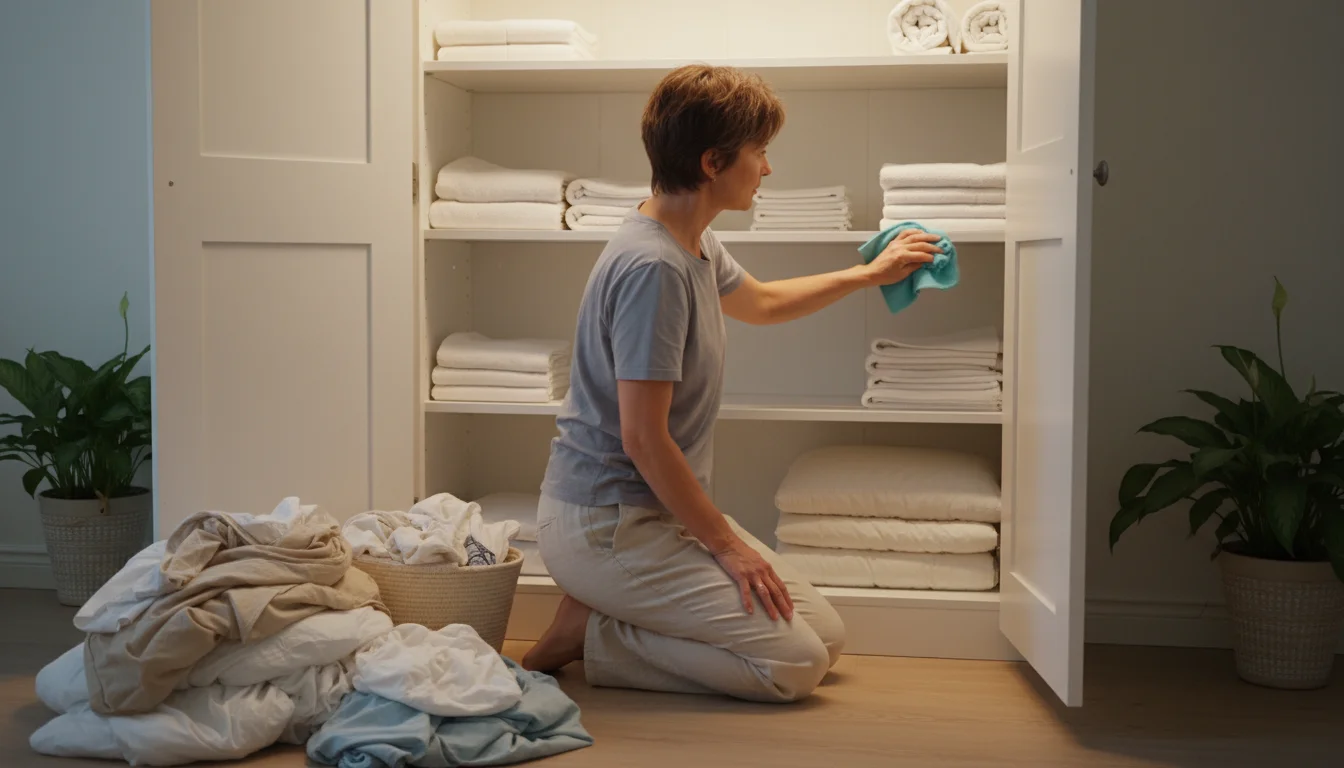
Seasonal Refresh:
Twice a year, perhaps in spring and fall, perform a slightly deeper review of your `linen closet organization`. This involves:
- Re-evaluating Inventory: Check the condition of all items. Discard anything worn out or stained. Reassess your needs. Have your family’s needs changed? Do you still use all the items you keep?
- Deep Cleaning: Remove all items and give the closet a thorough clean. Wipe down shelves, vacuum the floor, and check for any signs of pests or moisture.
- Adjusting Zones: If your habits or family needs have shifted, consider if your zones still serve you best. Perhaps you need more space for children’s bedding or fewer guest towels. Adjusting your system ensures it remains functional for your current life.
By integrating these maintenance practices, you do not just organize your linen closet once; you ensure it remains an organized, functional, and stress-free part of your home year after year.

Troubleshooting Common Linen Closet Challenges
Even with the best intentions for `linen closet organization`, you might encounter a few common hurdles. Addressing these proactively helps maintain your system and prevents frustration. Here are solutions to frequent problems:

Musty Odors:
Problem: Your linens develop a musty smell even after washing.
Solution: Ensure all linens are completely dry before you fold and store them. Even slight dampness fosters mildew and odors. Leave your closet door slightly ajar for air circulation. Place an open box of baking soda or a charcoal odor absorber inside the closet to neutralize smells. For a pleasant scent, use cedar blocks or lavender sachets, which also deter moths.

Pest Infestations (Moths, Silverfish):
Problem: You find small holes in linens or evidence of insects.
Solution: Store only clean, dry linens. Moths are attracted to dirty fibers. Use cedar blocks, cedar essential oil, or lavender sachets as natural deterrents. Regularly vacuum the closet and inspect items. For persistent problems, consider airtight bins for valuable or seasonal items. If you find significant infestation, remove everything, thoroughly clean, and consider professional pest control.

Stacks That Topple:
Problem: Your neatly folded stacks constantly collapse when you try to pull out an item.
Solution: Implement shelf dividers to create compartments, holding stacks upright. Use the vertical folding method for towels and sheets, which allows items to stand independently. Avoid overstuffing shelves. If shelves are too deep, use baskets or bins to contain items at the front, preventing back-of-shelf chaos.
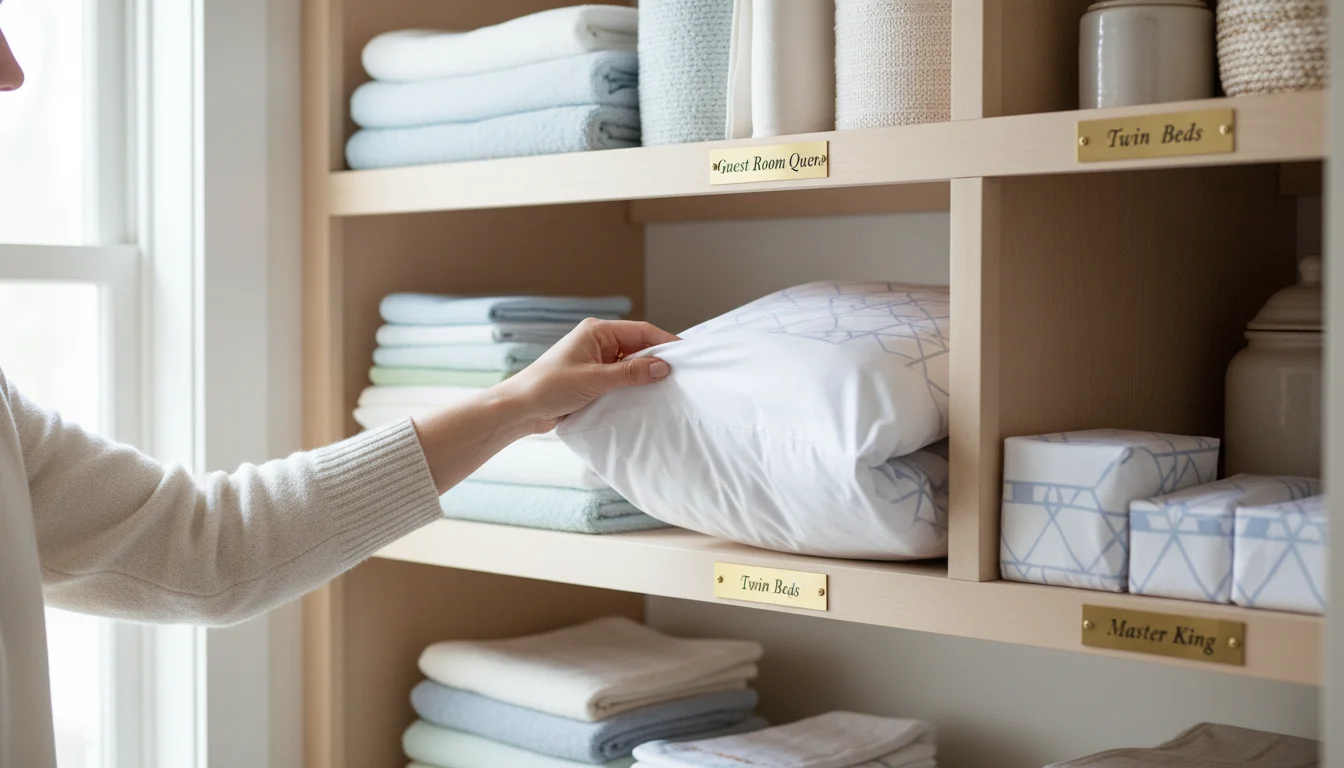
Difficulty Finding Matching Sets:
Problem: You struggle to find a complete sheet or towel set.
Solution: Store entire sheet sets inside one of their matching pillowcases. For `towel storage`, stack matching colors or styles together. Label bins or shelves clearly for “Master Bedroom Sheets,” “Guest Towels,” etc. This ensures you grab a complete set every time.
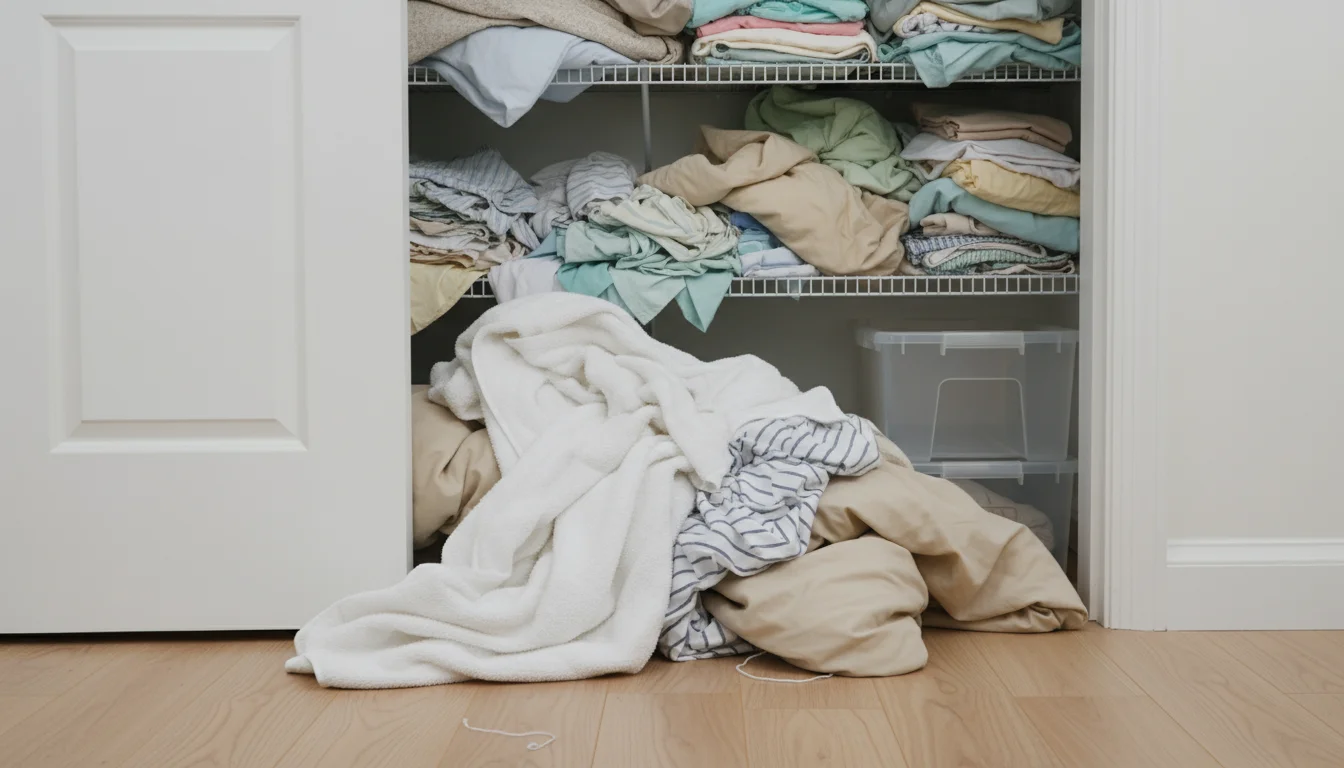
Over-Stuffing and Lack of Space:
Problem: You feel like you never have enough space, and your closet is always crammed.
Solution: Revisit your decluttering process. You likely have too many linens for your space or needs. Implement the “one in, one out” rule strictly. Utilize vertical space with stackable bins or risers. Explore non-traditional storage options if you simply have more linens than your closet can accommodate. Remember, effective `linen closet organization` means maximizing space, not stuffing every corner.
By addressing these challenges head-on with practical strategies, you protect your investment in your linens and ensure your organized closet remains functional and stress-free.

Frequently Asked Questions
How many sets of sheets do I really need?
Most households function well with two to three sets of sheets per bed. This allows one set on the bed, one in the wash, and one clean set ready to go. If you have guests frequently, consider an additional set for the guest bed. This amount provides ample supply without creating excess clutter for your `sheet organization`.
What is the best way to store blankets and comforters?
For bulky items like blankets and comforters, vacuum storage bags are highly effective for saving space, especially for seasonal storage. Alternatively, fold them neatly into compact rectangles and store them on the top shelves of your linen closet or in under-bed storage bins. Ensure they are completely dry before storing to prevent mildew.
Can I store cleaning supplies in my linen closet?
Yes, you can store cleaning supplies in your linen closet, provided they are safely contained and stored separately from your linens, especially if you have small children or pets. Use dedicated bins with lids for cleaning products, and place them on the bottom shelf for safety and to prevent accidental spills from contaminating fabric items. This contributes to comprehensive `linen closet organization`.
How often should I declutter my linen closet?
Perform a quick “tune-up” every few weeks to refold items and straighten stacks. A more thorough declutter and re-evaluation of your inventory is beneficial twice a year, such as during spring cleaning and before the winter months. This keeps your `linen closet organization` effective and prevents clutter accumulation.
What if my linen closet does not have enough shelves?
You can add extra shelving using tension rods, freestanding shelf inserts, or even by installing additional shelves if your closet structure allows. Over-the-door organizers also add significant storage without requiring extra shelves. These solutions help maximize your existing space for efficient `linen closet organization`.
For expert home organization guidance, visit
Consumer Reports — Home, This Old House, Family Handyman, Bob Vila and HGTV — Home.
Disclaimer: This article is for informational purposes only and is not a substitute for professional advice. Consult professional organizers or specialists for personalized recommendations.

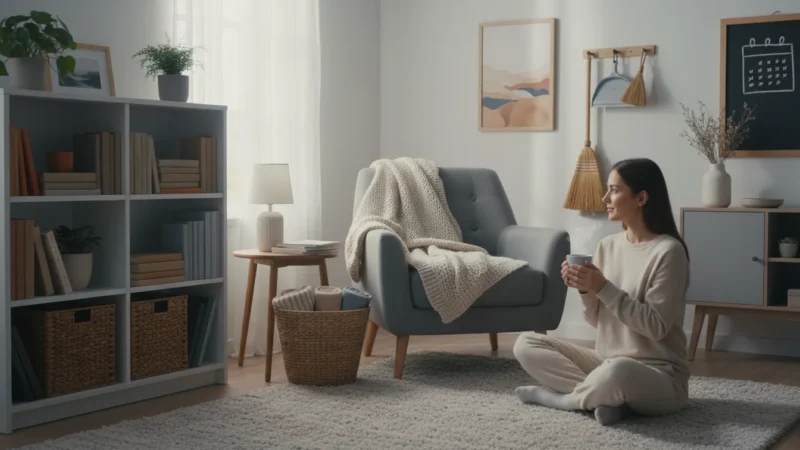

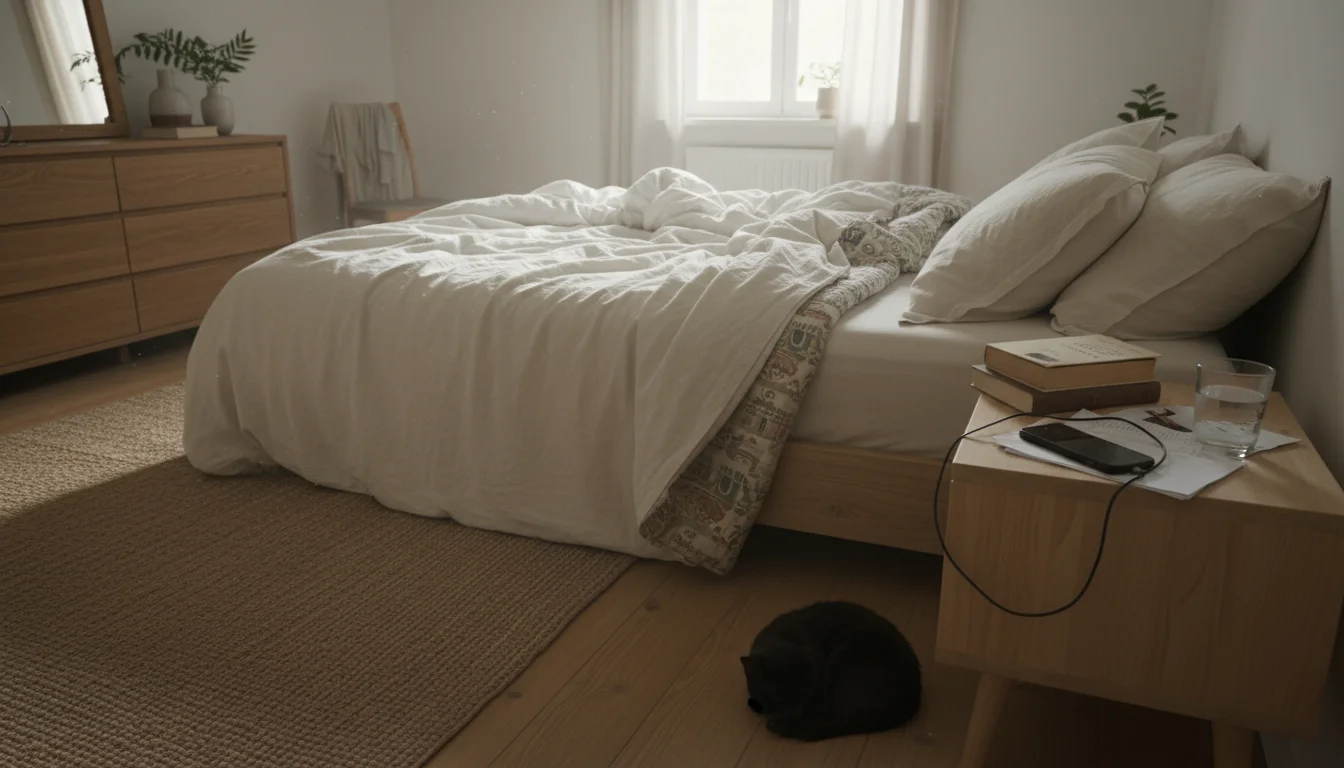
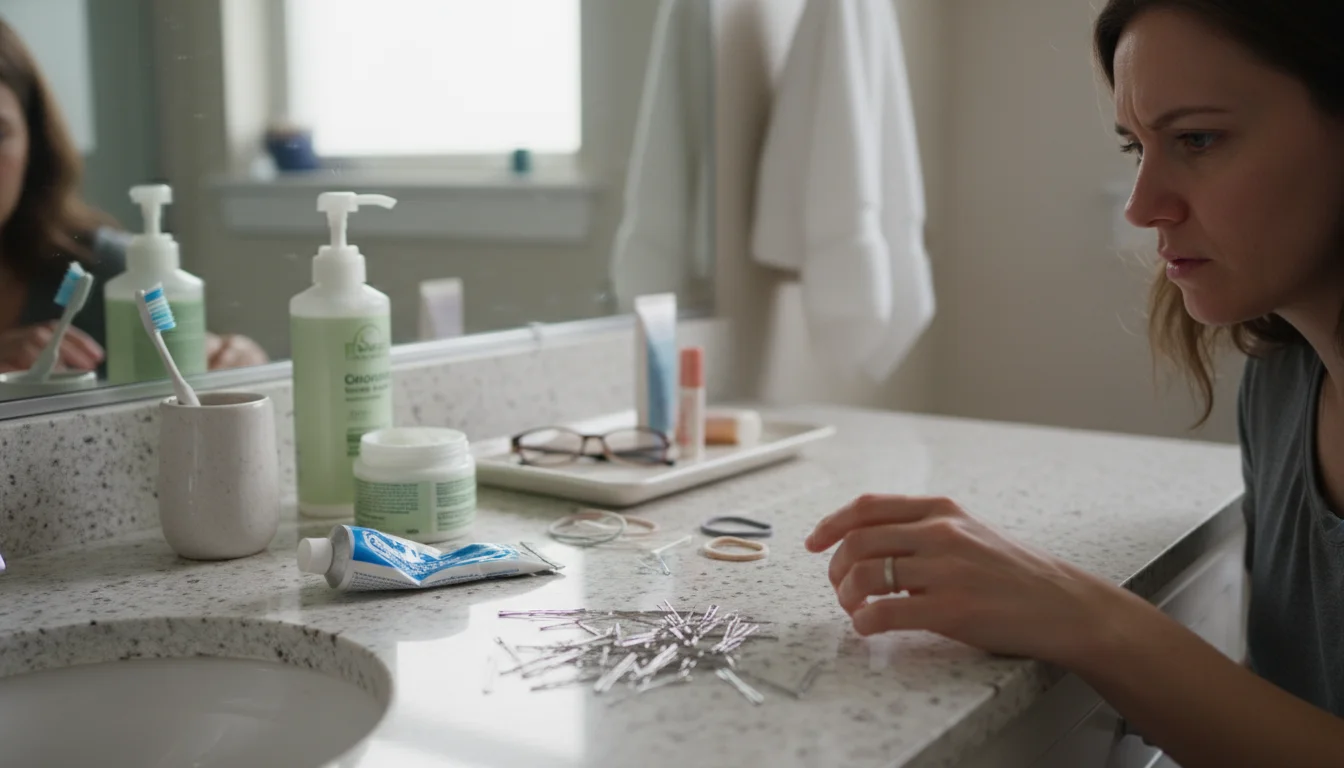
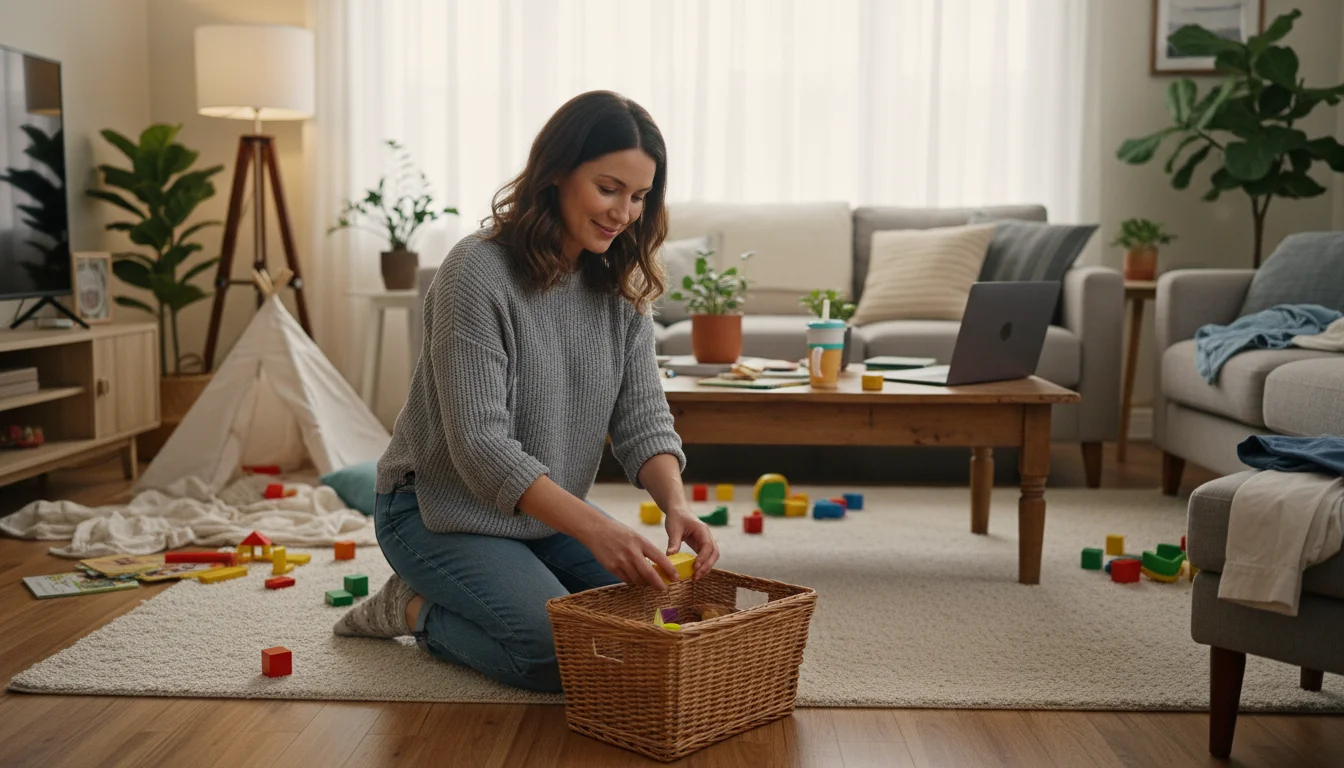
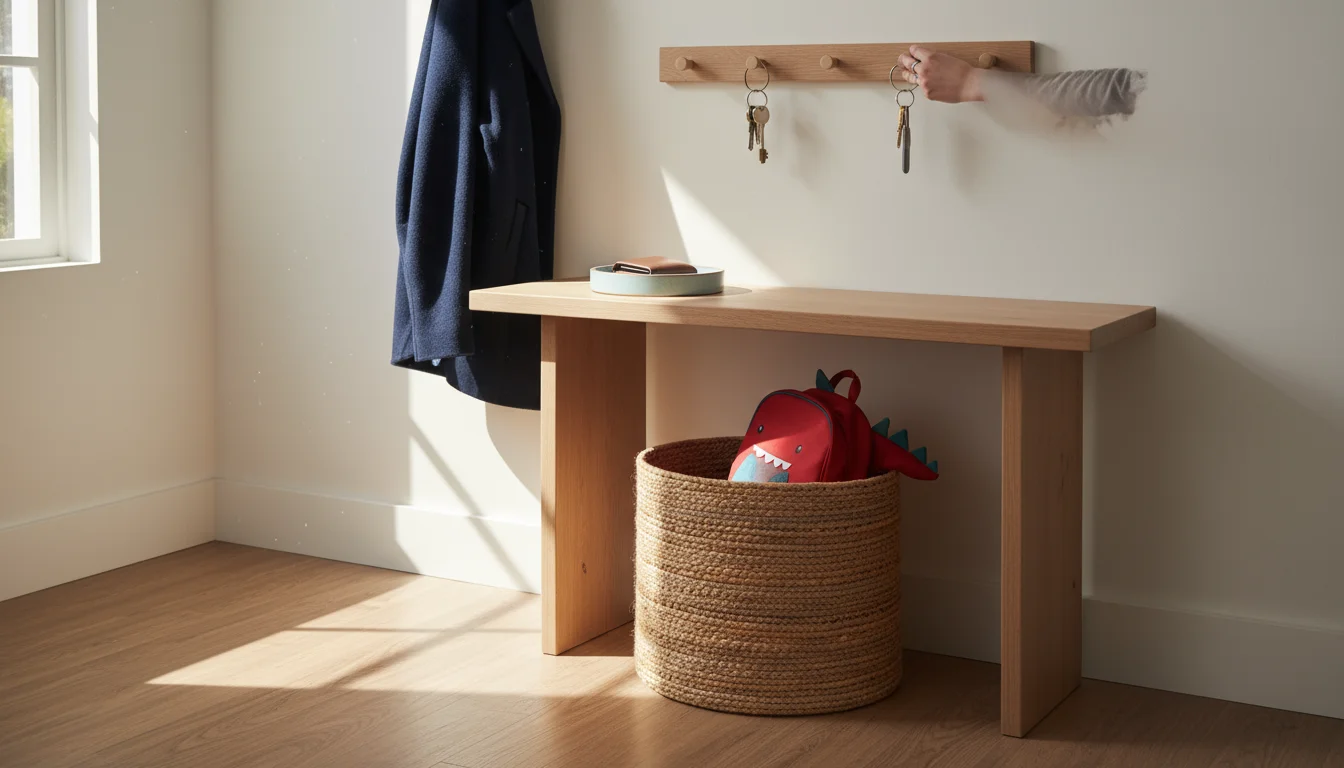


Leave a Reply